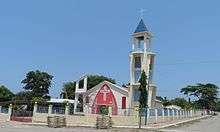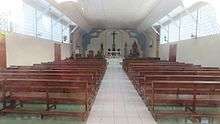Liquiçá Church massacre
| Liquiçá Church massacre | |
|---|---|
| Location | Liquiçá District, East Timor |
| Coordinates | 8°35′15″S 125°20′31″E / 8.5875°S 125.342°ECoordinates: 8°35′15″S 125°20′31″E / 8.5875°S 125.342°E |
| Date | April 1999 (UTC+9) |
| Target | East Timorese Catholics |
Attack type | Massacre |
| Deaths | ~200 |
| Perpetrators |
Pro-Indonesia militias (mainly Besi Merah Putih) |
The Liquiçá Church massacre was a mass-killing that occurred in April 1999, during East Timor's bid for independence. It was the first case to be heard by the Second Special Panel.
Events and Aftermath


During the event, up to some 200 East Timorese people were murdered at the Liquica priest's house next to the local Catholic church.[1] The event left many witnesses, including the local Catholic Priest, Raphael dos Santos. The total number of victims at the hands of pro-Indonesia militias (primarily the Besi Merah Putih) and Indonesian soldiers and police in Liquica has never been fully determined, ranging from a low of five[2] claimed by Indonesia, to more than 200 by local sources.
The crime was first investigated by Australian diplomats at the invitation of the Indonesian Government, but the report wasn't released until 2001.[3] Later it was investigated by a team of International Police which became known as the UNTAET Crime Scene Detachment, serving under the United Nations and representing the countries of the United States, Great Britain, and the Philippines, as well as Australian and New Zealand Military Police Crime Scene Specialists. The unit was initially commanded by police officer Steve Minhinett, of Great Britain. It was later commanded by American police officer Karl Clark, and relied heavily on American intelligence officer Allen Williams. This investigation led to a large number of exhumations of the dead, witness statements taken, and ultimately charges of assassination, torture, forced deportation and murder being filed against 21 Indonesian Officers, and pro-Indonesian East Timorese Militia.
The Liquiçá Church massacre and the attack at Manuel Carrascalão's house were two of the ten priority investigations of the Serious Crimes Unit. This case was the first of several indictments arising from these investigations to reach trial. The trial was the first to be heard by the Second Special Panel, consisting of Judge Benfeito Mosso Ramos (Cape Verde) presiding, Judge Antero Luís (Portugal) and Judge António Helder (East Timor). The hearing was conducted in five languages: Portuguese, English, Indonesian, Tetum and Tokodede, the local language of the Liquiçá area. The court heard detailed testimony from the accused about involvement in the Besi Merah Putih militia, including a militia ceremony in which they were allegedly forced to drink a cocktail of alcohol, animal blood and drugs before killing, as a part of the attack on the Liquiçá Church. Testimony implicated the direct participation in the attacks by Indonesian soldiers, who were allegedly dressed in civilian clothes to look like militia members. Leoneto Martins, Tomé Diogo, Eurico Guterres and João Tavares were the primary suspects and leading figures during the massacre, all were East Timorese.
A prominent business associate of the Suharto family and "spokesman for the Indonesian Loyalist faction", Gil Alves, confirmed to the media that "the Red and White militia [Besi Merah Putih] had conducted the attack. But he said the attack started after shots were fired from inside the church grounds. He claimed that the Red and White had surrounded the priest's home to disarm members of the CRNT (anti-Indonesian forces loyal to Mr Xanana), who had stored weapons there. He said the police were present to prevent violence and fired tear gas in self-defence. He denied that the militia had been armed by the Indonesian military, as Mr Xanana has claimed." (Tim Dodd 'Massacre has Timor living on the edge' Australian Financial Review, 9 April 1999). However, in 2007 Xanana Gusmão, as Prime Minister, appointed Gil Alves his Minister for Commerce and Tourism.
See also
References
- ↑ East Timor in Transition 1998–2000: An Australian Policy Challenge, DFAT, 2001, p63
- ↑ Aglionby, John (8 April 1999). "Army blamed for Timor massacre". The Guardian. Retrieved 27 January 2018.
- ↑ East Timor in Transition: An Australian Policy Challenge, DFAT, 2001, pp185-9
External links
- Sydney Herald, Williams and Other Investigators Estimates
- ABC Online article on negotiations with Australia about border
- Genocide Watch, Besi Merah Puti - Alan Williams
- Health Alliance International website - More information on health projects in East Timor by HAI
- Jornal Nacional - Semanário (Portuguese)
- Links to Timor Leste government sites
- Ministry of Foreign Affairs and Cooperation
- Suara Timor Lorosae - (Tetum and Indonesian)
- CIA World Factbook on East Timor
- ETAN Links - Extensive links on East Timor
- Governo Timor Leste - Official governmental site